| Diese Seite auf Deutsch! |
|
The Striped Helix or Turkish SnailHelix lucorum Linnaeus, 1758 |
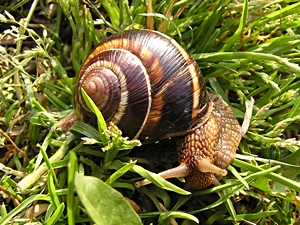 Striped Helix (Helix lucorum). Picture: Robert Nordsieck. |
The Striped Helix (Helix lucorum) or Turkish Snail, in French is called Escargot Turc as well. And indeed the species' distribution area largely covers the ancient region of Asia Minor, including the present-day area of Turkey and parts of the Balkan peninusla.
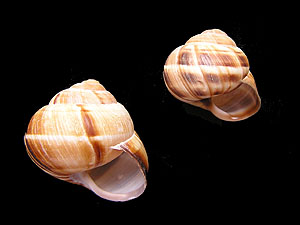 Striped Helix (Helix lucorum), light and dark variant. Picture: Robert Nordsieck. |
It can be readily distinguished from the Central European Roman Snail (Helix pomatia) by the colour pattern of its shell. As its name suggests, the Striped Helix Snail usually displays a distinctly banded pattern. Several broad reddish-brown longitudinal bands may fuse into wide stripes, leaving only little of the original lighter shell colour visible.
In very light-coloured variants, the transverse growth lines produced during estivation may dominate the shell pattern, so that the snail appears cross-striped. Another distinguishing feature from H. pomatia is the shape of the shell aperture, which is set slightly oblique and has a thickened lip. The lip margin is reddish to brownish in colour.
Dimensions: W: 40-50 mm, max. 60 mm. H: 41-55 mm.
![]()
With a diameter of 30 to 60 mm, the Striped Snail is usually distinctly larger than the native Roman Snail Helix pomatia. How large it can grow strongly depends on the prevailing temperature and humidity of its habitat.
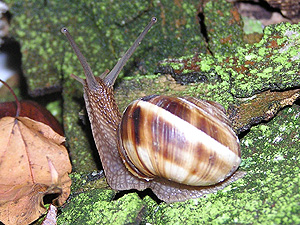 Striped Helix (Helix lucorum), juvenile specimen. Picture: Robert Nordsieck. |
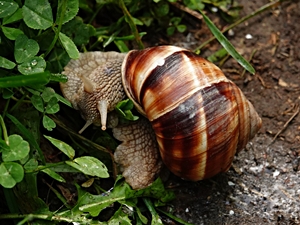 Helix lucorum: Dschermuk, Vayots Dzor, Armenia. Picture: Vincent Rufray (iNaturalist). |
Its distribution extends from the eastern Black Sea region
across Asia Minor and the central Balkan Peninsula (southern Romania, Bulgaria,
and Thrace in north-eastern Greece, westwards to Albania) to Italy west of the
Apennines (![]() Distribution Map). Greek settlers evidently also introduced H.
lucorum to the Crimean Peninsula (Ukraine) (cf. Korábek et al. 2018, see below).
Distribution Map). Greek settlers evidently also introduced H.
lucorum to the Crimean Peninsula (Ukraine) (cf. Korábek et al. 2018, see below).
In Germany, H. lucorum occurs only locally, with records from Bad Godesberg and Munich (Henkel, H. 2015). In Austria, the species has been recorded from the Vienna area (Fischer, W. et al. 2008). In contrast to the Brown Garden Snail (Cornu aspersum), the Striped Helix Snail apparently is not spreading in Lower Austria.
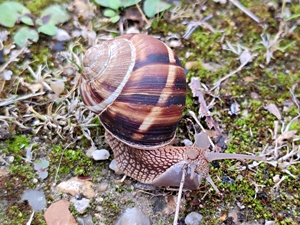 Striped Helix (Helix lucorum): Yvelines, Île de France, France. Picture: Camille Robin (iNaturalist). |
The same is the case in southeastern Europe, where only natural populations are harvested, especially the large-sized subspecies Helix lucorum taurica (cf. Korábek et al. 2018) and other robust Anatolian forms.
In delicatessen shops one often encounters the meat of Helix pomatia bred in snail farms, but sold in the more attractively coloured shells of H. lucorum.
In southwestern France (Départements Aude, Aveyron, Haute-Garonne, etc.), the Striped Helix Snail is now spreading widely in the wild, in some places occupying the ecological niche of the originally native Cornu aspersum and displacing it. In this region, specimens of H. lucorum with shell sizes just under 6 cm have been recorded.
In the appendix "Snails of Mediterranean France" (Kerney, M. P., in: Kerney, M. P. et al. (1983): Die Landschnecken Nord- und Mitteleuropas, pp. 285 ff.), the following was written about H. lucorum (p. 309): "Originally native to southeastern Europe, the species has been established in gardens near Lyon and probably also elsewhere in southern France.".
In 2010, the species was also reported from Le Vésinet, a western suburb of Paris. The authors of the study assumed that H. lucorum would continue to appear elsewhere in France and Europe wherever these snails are traded.
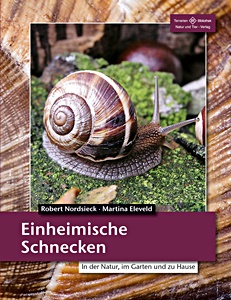 Striped Helix (Helix lucorum) on the cover of "Einheimische Schnecken". |
Links
Literature
Latest Change: 28.09.2025 (Robert Nordsieck).